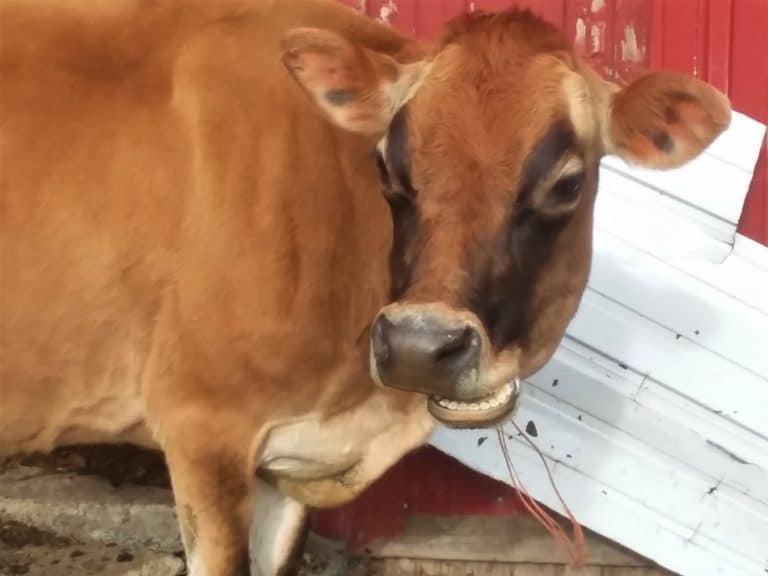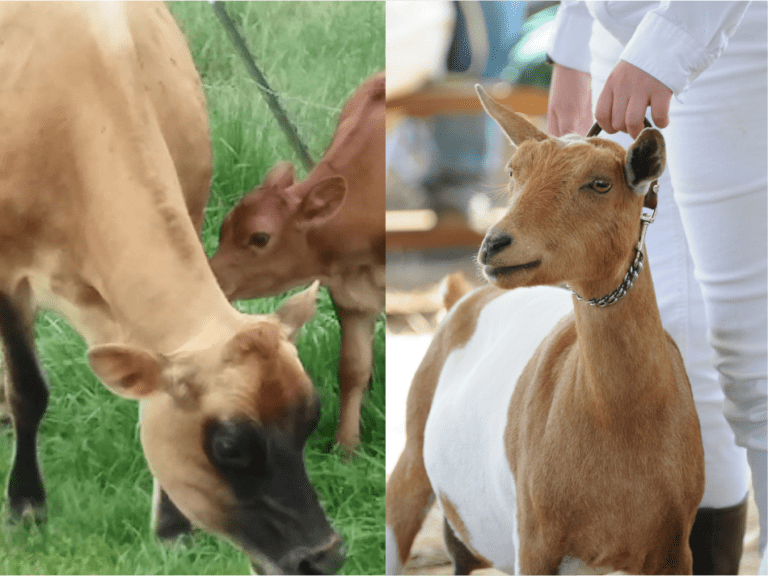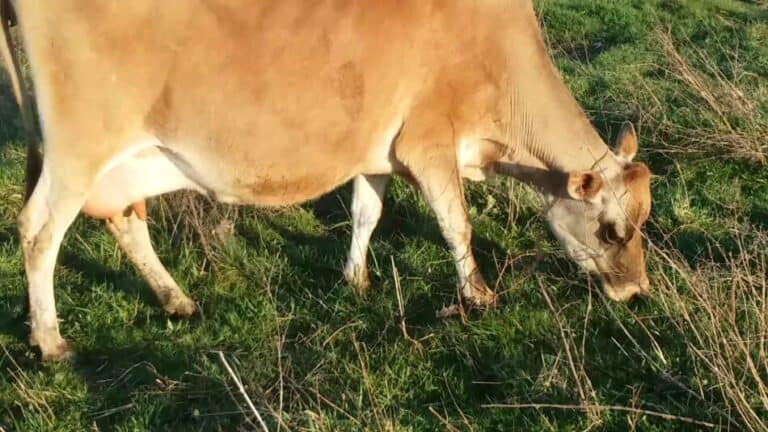Family Milk Cow: The 5 Best Breeds For Beginners

Getting a family milk cow is a great way to step up your game! If you’ve got a little bit of land and the willingness to learn, having your own cow is definitely doable.
Now, let’s talk breeds. What breed will suit you and your family the best?
The top family milk cow breeds for the U.S. are Jersey, Brown Swiss, Milking Shorthorn, Ayrshire and Guernsey.
Loads of nutrient dense milk, making your own cheeses, butter and yogurt-that’s an exciting prospect to any potential family cow buyer!
We love our cow and the plentiful milk she provides. In exchange for a little bit of daily care we get 2-3 gallons of real milk, everyday, to do with as we please.
How do you know if you’re ready? My guide “Are You Ready For A Family Cow?” will walk you through the things you need to have figured out, including feeding needs and daily care, before you get your cow.
Cost Of A Family Cow will show you how to find the cost of a dairy cow in your area.
Before we go any further, you should know that we used to milk cows for a living.
Bias alert-we had mostly jerseys! The insights and opinions I’m giving you are from hands on experience with these breeds.
To get the cow that suits you and your family the best, you need to be focusing your attention on easy care, economical cattle that you are likely to be able to find in your area.
Breed is only part of that criteria, the individual cow matters more than her breed.
Daily Care Of Your Family Cow will go over the steps you need to take to keep your cow happy and productive.
None the less, breed is always an easy place to start and will give you and your family some overall guidelines to get you started. Let’s get to it!
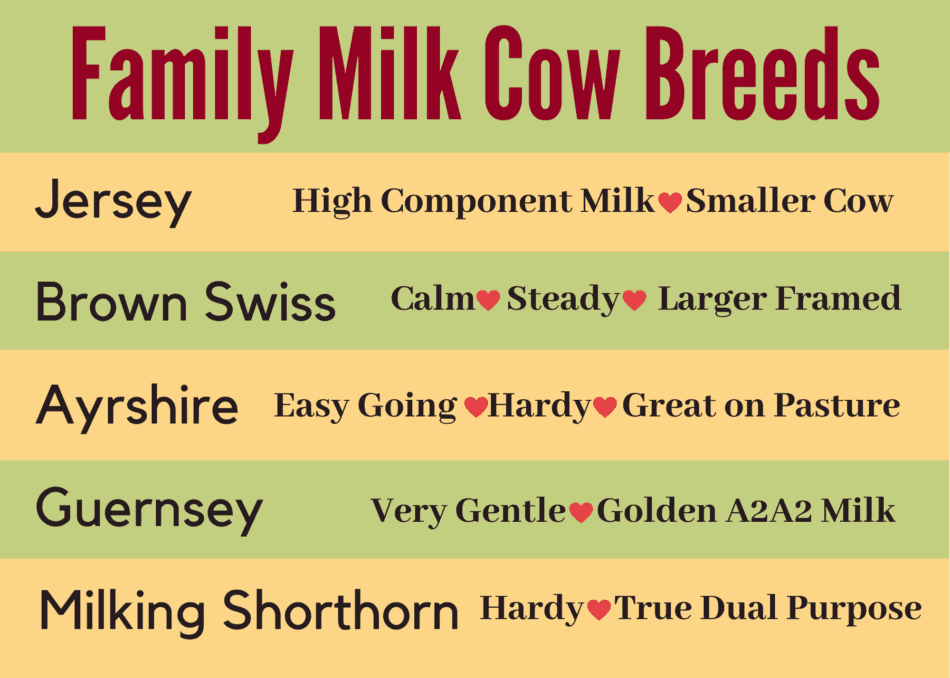
My list of family cow breed criteria
- Easy to get along with attitude
- Easy care, low maintenance
- Hardy, doesn’t need coddled
- Economical to buy and keep
- Likely to be available for purchase
A few notes before we get started
Attitude is the most important criteria on the list! Poor attitude is a deal breaker, no exceptions!
For a complete list of selection criteria, read my article Choosing A Family Cow.
Be sure to buy a cow, not a heifer! Heifers are untrained and unproven, you never know what you are going to get.
A cow knows the game and is more of a sure thing, do yourself a favor and buy a cow! I’ve read run across some articles suggesting you buy a heifer, please don’t.
Do yourself a favor and buy the cow!
How Much Milk Will You Get From Your Family Cow? goes over the likely production from your cow and what you can do to influence the amount of milk you get.
Jersey: the best family cow breed!
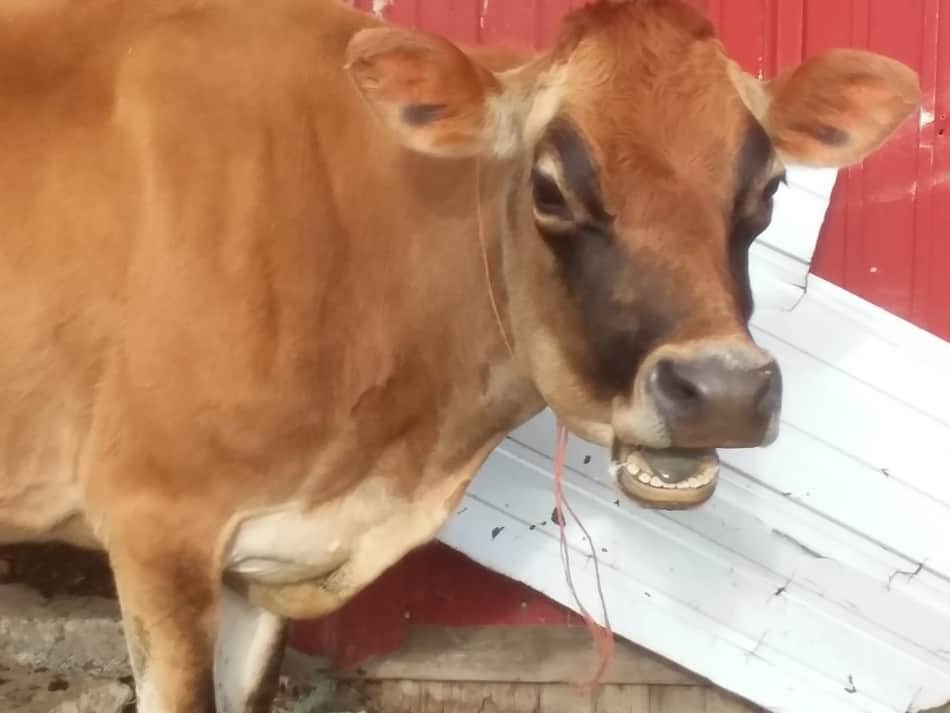
Jerseys overall are known for:
- Rich milk
- Smaller size
- Easy calving
- Lots of personality
- Active and alert
- Commonly found in dairy areas
Biggest advantage with Jerseys: Incredibly rich milk
Biggest challenge with Jerseys: Active and alert cow
Jerseys are fun little cows! As far as dairy cows go, Jerseys are active and have quite a bit of personality.
Other cows just seem a bit slower and a little bit more dull than a Jersey.
As I mentioned above, we have always had a majority Jersey herd, we just like them.
We’ve tried a few other breeds on and off, but none compare to the Jersey as an overall easy to have around, healthy, great little cow.
How do you know if you’re ready? My guide “Are You Ready For A Family Cow?” will walk you through the things you need to have figured out, including feeding needs and daily care, before you get your cow.
Our family cow-Aleene
I’m sure you’ve read in other places about the richness of Jersey milk-it’s true! Your first taste of real Jersey milk will be a treat and spoil you for life!
Our current family cow, Aleene (pictured at the top), is a 14 year old Jersey that milks 2-3 gallons per day on grass (and in the winter hay or haylage) alone, no grain.
This is plenty of milk for us. If we gave her grain, it would increase her production.
Since we don’t need more milk and the hay and haylage look like they are giving her the nutrition she needs, she doesn’t get any grain.
Family Cow Milk Production will help you understand you cow’s milk production cycle.
Smaller cow takes less feed
Since Jerseys have a smaller body size than the other breeds on this list, they also take less feed per day.
That’s less hay for you to source and less pasture that you will need to provide compared to a larger breed cow.
Jerseys are known for calving ease
A big advantage for the first time family cow owner that you might not think about is that Jerseys are known for calving ease.
In all of our years milking, pulling a calf was a rare occasion if the mom was a Jersey or Jersey cross.
Getting Your Family Cow Bred Back goes over when and how to get your cow rebred so she’ll keep on a good production cycle and you’ll keep getting milk!
Jersey have a different attitude
I do have to admit a Jersey can be a bit of a twerpy little cow.
If you think she’s not watching, “I can leave that gate open, Aleene didn’t see me” think again. She’s just good at looking like she’s not watching. If it involves food, she saw it!
If you are used to other breeds of cattle, Jerseys are more active. Some people find this to be annoying, I’ll admit.
Since we started out with Jerseys, it always amazes me how slow most other breeds seem in comparison.
Overall, a Jersey is my best answer to the question “What breed of dairy cow should we get for our family cow?”
As always, temperament of the individual matters more than the breed, but as a reliable first cow, try Jersey.
A note on miniature Jerseys: miniature animals in general will be harder to manage than their full size counterparts.
It tends to be that size and color are selected over more important things like calving ease, easy care and structural correctness.
To be clear, we have never had a mini Jersey. However, we have seen that mini anything seems to have more management problems than their normal size peers.
If your heart is set on a mini, make doubly sure you get the details on calving ease, production (amount and length of lactation) and ability to find and use unrelated bulls.
Brown Swiss are hardy and calm
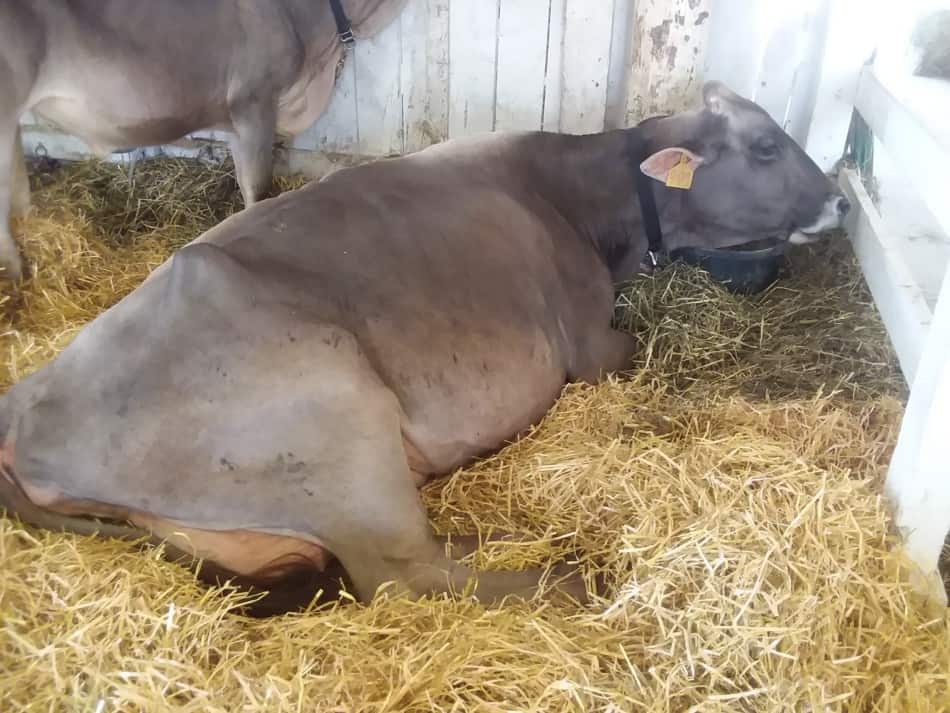
Brown Swiss are known for:
- Docile attitude
- Higher component milk
- Nice size calves
- Can be stubborn
- May be bossy to other cattle
- Needs a high amount of forage
- Can have problems with calving
Biggest advantage with Brown Swiss: easy going attitude
Biggest challenge with Brown Swiss: larger sized cow
Our first experience with these gals was when we bought a beautiful Swiss cow named Twinkie. I loved her-big, beautiful, calm-she was great!
I really enjoy a great looking Swiss, they truly are lovely cows!
Since we had mostly Jerseys, we were a little concerned that Twinkie would be a big meany. That wasn’t the case at all!
If anything the little Jerseys went out of their way to try to pick at her.
Actually, it was funny, since try as they might to move her, Twinkie just acted like the little Jerseys weren’t even there!
Swiss are calm, steady cows
The claim to fame for these gals is that they are easy to be around, calm cattle. So true! Steady and calm is exactly the Brown Swiss way.
If you are looking for a calm cow with some size, to give you a good size calf each year, a Swiss is one to consider.
Bigger cow=more feed needed
Since a Swiss is a bigger cow, she will need more feed, no surprise there! If you are not planning to feed any grain, this may be an issue.
Of course, what your cow needs to eat will depend on the forage she is getting and her metabolism.
Just be aware that to keep up with her body’s needs she is likely to need a bit of supplemental grain, especially when forage quality is poor.
Swiss cows can be stubborn
Swiss can also be stubborn.
Here’s an example: at our state fair dairy show it is not unheard of to see some of the cattle in the Swiss show (not the other breeds, mind you) lay down in the show ring and just refuse to move!
When she’s ready, she’ll get up. Until then, she’ll just stay where she’s at. Most cattle can be like this a little, Swiss just seem to be really good at it.
Swiss have high birth weight calves
The last potential are of concern with Swiss cattle is calving ease. Any of the bigger boned breeds of cattle can have difficulty calving.
Don’t let this scare you off the breed, just keep it in mind.
A few ways to reduce the likelihood of calving problems is to keep your cow in good shape, give her plenty of exercise and if you are using A.I. (artificial insemination) choose a bull rated for ease of calving.
Ayrshire are hardy grazers
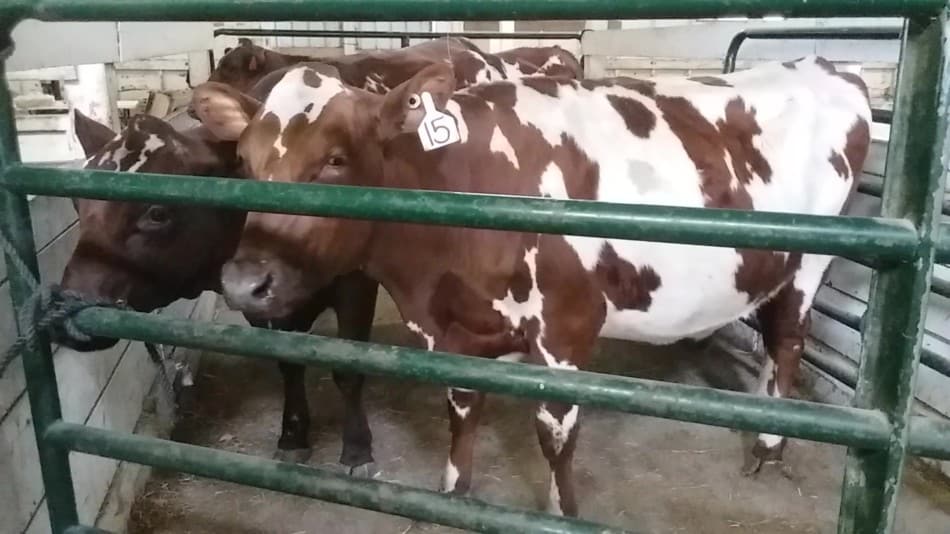
Ayrshires are known for:
- Hardiness
- More of an adventurous eater
- Can be bossy with other cattle
- Larger bodied
- Long horns (if not dehorned)
Biggest advantage with Ayrshires: hardiness
Biggest challenge with Ayrshires: attitude
We bought two Ayrshire heifers at a dairy sale to see how they would fit in our herd.
They are a nice, substantial cow and a real go getter, as far as diving in and getting her share of the feed.
Ayrshires also seem to do well on grass. They are a nice sized cow with a lot of capacity (big tum to hold lots of grass) and seemed to stay in shape with minimal effort.
As far as attitude goes, these are nice gals to be around. They are pretty easy going cows around people.
Ayrshires are potentially pushy with other cattle
I have to admit, the biggest bully we had in our herd was one of the Ayrshires we bought.
Her name was Nidget. She had a partial horn that she was all to happy to use on her herdmates.
For this gal, no feeder was ever big enough for her to share some space with the others! (Once again, always well behaved around us.)
The good news is she was easy to keep in great condition. The not so good news is she needed to be monitored to keep her from being mean to others!
Not a problem if your cow is by herself, something you need to watch if she’s overly pushy with her peers.
Ayrshires genetically have longer horns
The Ayrshire has the ability to grow some really awesome horns, they are oxen favorites for this very reason.
If you are not planning on dehorning your cattle, you need to be aware of the larger size horns your cattle will be growing.
If you are okay with the horns, no worries.
If not, you’ll need to have a plan to remove the horns (a vet can do this for you) or if that is unacceptable to you, choose another breed.

Guernsey are easy going
Guernseys are known for:
- Wonderful attitude
- Golden color to the milk
- More difficult to find
- Recent breed trend is toward larger framed cattle
Biggest advantage with Guernseys: calm, mild mannered
Biggest challenge with Guernseys: finding them
The Guernsey is a breed that we have not ever owned. Kind of crazy, since we have had tried a few of many other breeds of dairy cattle.
So how can I give you hands on advice for something I’ve never owned? In this case we are substitute milkers for a friend who has a herd of dairy cattle, many of which are Guernseys and Guernsey crosses.
We spend a few weeks every year with these gals.
Are Family Cows Affordable? shows you how to calculate the costs and benefits of getting your own cow.
Guernseys are calm, easy going cows
The first thing I notice about a Guernsey is how nice she is and what a sweetie to be around. They are just a calm, sweetheart of a cow.
I was at a dairy sale this fall, with just one Guernsey in the catalog. Such a nice gal and an ideal family cow prospect.
She was also A2A2, as are most Guernseys.
How do you know if you’re ready? My guide “Are You Ready For A Family Cow?” will walk you through the things you need to have figured out, including feeding needs and daily care, before you get your cow.
A2A2 milk is common in Guernseys
If you are not familiar, A2A2 milk is the easier to digest milk.
If you’ve heard that some people can digest goat’s milk but not cow’s milk, what this really means is they can digest A2A2 milk, but not A1 milk (produced by the majority of Holsteins and less frequently in other dairy breeds).
What Is A2 Milk? is a FoodMedicine101.com article that gets more into the science of A2 milk.
Guernseys have a golden tint to the milk
Guernseys naturally have a yellow tint to their milk. Butter made from Guernsey milk will naturally be yellow.
In the days before Holsteins were popular, Golden Guernsey cow was the thing to have for this very reason.
Guernseys are more difficult to find
The most difficult thing about getting a hold of a Guernsey is finding one.
If you live near a show herd, consider yourself lucky, you’ll have the best shot of anyone in regards to getting a nice Guernsey family cow.
Breed trend seems to be toward larger cows
The other thing we have noticed breed wise, is that the Guernseys seem to be moving towards a larger framed cow.
A bigger bodied cow will take more feed to maintain than a smaller bodied cow. This is a case of bad for the small farmer, but seemingly the direction the show genetics are headed.
This doesn’t mean all Guernseys are hard to keep, it just means choose a smaller bodied cow that keeps weight on easier.
Milking Shorthorn are dual purpose
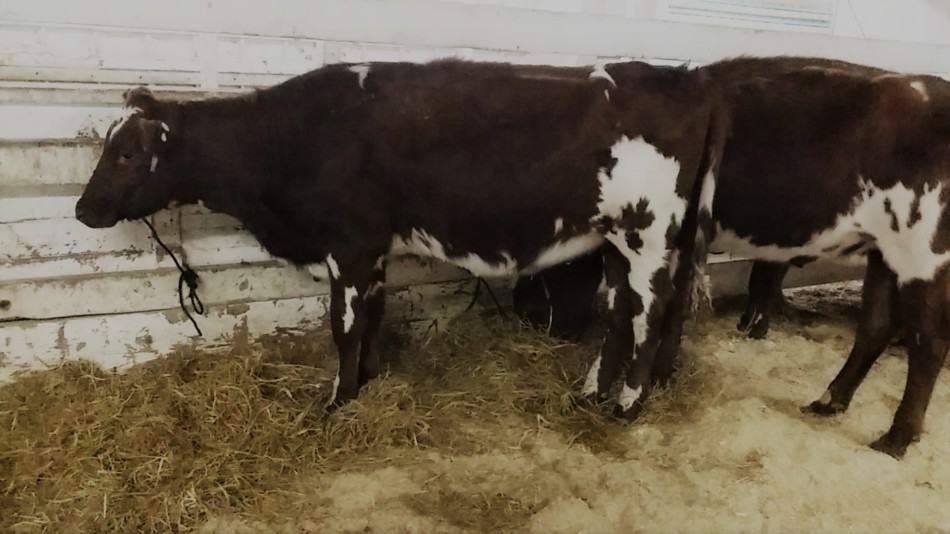
Milking Shorthhorns are known for:
- Dual purpose cow
- Will take care of her own needs first
- High reproductive efficiency
- High cheese yield
Biggest advantage with Milking Shorthorns: true dual purpose breed
Biggest challenge with Milking Shorthorns: finding them
We had some Milking Shorthorns in the herd with the Jerseys. I like a bit of a beefier cow, especially for a small farm or homesteading situation.
If you want your cow to be able to do more work themselves, like milking on grass and not needing much barn wise (she’ll still need some shelter), consider Shorthorns.
Some of the most beautifully marked cows I have ever seen were dark roan Milking Shorthorns.
The red part of the roan was so darkly pigmented it was almost purple, I love the roan pattern! Wow, they are lovely cows!
Shorthorns tend to keep body condition
For the most part, Milking Shorthorns will drop in milk production before they drop in body condition.
This is a good thing for a small producer with little experience feeding a dairy animal.
She will save herself and just cut back on milk production rather than milk herself down to nothing (and get sick) because you don’t have her ration correct.
There are some exceptions!
Our first Milking Shorthorn was from a highly productive dairy line and she was a milking machine!
Her name was Breyer (and I still miss her). She was a light roan with a very dairy build and wow, was she a milker!
Great for us, as dairy farmers, probably too much of a producer for a family cow.
Stick with the more substantially built cows and you’ll be right on target for a family cow.
Steady and occasionally determined attitude
In our experience, Shorthorns are mild cattle with steady temperaments. I do have to admit, once a Shorthorn gets an idea into her head, she does it.
If she decides she’s going somewhere, good luck stopping her, she’ll just push until it works. I call it “tanking it over” (tank, as in military type tank).
All cattle have a little bit of this in them, Shorthorns just seem to have a bit more than most.
Shorthorns rebreed well
One of the most notable characteristics of a Shorthorn is that they seem to be easy breeders.
We never had to cull a Shorthorn for not breeding back, it’s just not a problem for most of these gals.
Shorthorns have lots of variability in genetics
Some of the cows can have more of a beef structure and we did have a few with just the opposite build, very lanky and hard to keep weight on.
How to deal with this? It’s simple, just watch what you buy to begin with.
The fall dairy sale I went to had a few Shorthorns run through, they were beautiful and full of dairy character.
Actually, I was glad I was just there to watch. Deciding which one to buy would have been tough, tons of great cow and heifers there.
They were all younger stock (you’re always guessing with younger cattle), but from what I could tell in a few years any one of them would have made a great potential family cow.
Each dairy breed has great traits
Each breed has wonderful traits and a drawback or two. So, how do you choose?
While there is not one perfect breed, there is a close to perfect breed for you.
Still need some help? Here’s my suggestion: Think about the thing that matters to the most and the things that are unacceptable or drive you crazy.
Here are a few examples to get you thinking:
- If you don’t want to pull a calf, get a Jersey, no question.
- If you want a calm cow, get a Guernsey or Brown Swiss.
- If you want a hardy cow that can do pretty well for herself, get a sturdily built Ayrshire.
I love cows and truly believe that there is a breed for everyone.
Think about the things that you actually want and need from your family cow (meaning move past looks).
Buy from a dairy breeder with experience
There are a lot of well meaning people out there who get a cow (or worse yet a heifer) then have problems and are willing to sell cheap.
I see this all of the time on the free online ad platforms.
Resist the temptation. Get an experienced cow from a person who knows and loves dairy cows.
Not only will you get a better animal, you’ll also have an invaluable resource who can help you work through any challenges that come up with your cow.
A low producer on a dairy farm could be a great family cow
An often overlooked opportunity to get a great cow is to buy an older cow from a commercial dairy farm.
A cow that has a great attitude, 4 good teats and quarters, but is just too low of a producer can be a great family cow choice.
This cow must be healthy and have a wonderful attitude. If she does, consider buying her.
Our family cow, Aleene, would have been sold a few years ago if we were still milking for a living.
Since we are keeping her as a family cow, what would be an almost embarrassingly low amount of milk for a commercial dairy is great for us.
How do you know if you’re ready? My guide “Are You Ready For A Family Cow?” will walk you through the things you need to have figured out, including feeding needs and daily care, before you get your cow.
Breeds that didn’t make the list
It’s quite possible a dairy breed you were looking into did not make my top five list.
Does that mean you have to agree with me? Of course not!
However, I do have my reasons. (These are not arbitrary, most popular or random selections.) You can get any breed you fancy or is available to you. The breeds on the list are just more likely to work well for beginners.
A caution regarding breed selection
We have come across multiple well meaning beginners who have chosen a breed of cow that was not very beginner friendly.
With some practice and experience these cows would have been a fine choice.
For a person new to cattle and milking, it was too frustrating and, unfortunately, heavily influenced their decision to give up the dream of having a family milk cow.
If your heart is set on a specific breed, don’t let me stop you.
Just be aware that some breeds and individual cows are much more likely to be successful for new owners than other breeds.
If the breed you are interested in did not make this list, consider reading my article 12 Dairy Cattle Breeds.
Seven additional dairy breeds that are available in the U.S. are in this article (but not listed here) with my opinion regarding their suitability as a family milk cow.
Please note: There are also multiple dairy breeds popular in other parts of the world that are not available (or rarely available) here, so they did not make my top five either, simply due to availability.
If you are looking for another perspective on dairy breeds, consider reading the Farm and Dairy article How To Identify Common Breeds Of Dairy Cattle.
It includes more of the background information on each breed and has some great pictures.
How do you know if you’re ready? My guide “Are You Ready For A Family Cow?” will walk you through the things you need to have figured out, including feeding needs and daily care, before you get your cow.
